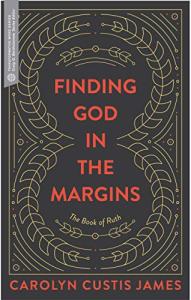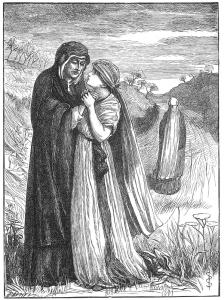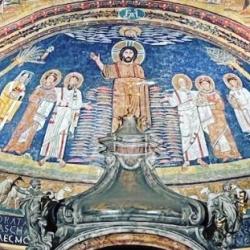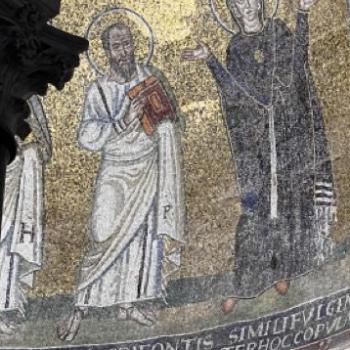
I am famous in my family for looking for an item I’ve “lost” only to come back later and discover it sitting in plain sight. “Where did this come from?” I will ask indignantly, as if my husband or children surreptitiously placed it there after I’d left the room. Only, it had been there all along, and I just couldn’t see it. Why? It had become part of the setting, so common and present that it was virtually invisible. But once it was brought to my attention, I couldn’t imagine how I missed it.
My theological journey resembled my penchant for missing what has merged into the background. Specifically it took many years for me to wonder what God thought about patriarchy, or, male rule. Coming out of my childhood Catholicism, I walked into a conservative (“Bible teaching” as I understood it) Bible church founded in the aftermath of a Billy Graham crusade. Male leadership in the church was so ingrained in me in both settings that I never thought twice about it. Male priests, male preachers, male pastors—the church service might look different, but the leadership style remained consistent.
I loved theology so much that I jaunted off to seminary directly after college and soaked in six years of excellent training in how to study and communicate the Bible. The more I learned, the more questions arose regarding male authority as God’s plan for humanity. But I was trained to interpret God’s Word from a grammatical-historical perspective, and the dominance of patriarchy was undeniable.
In several places, the biblical authors directly noted what leadership looked like, and it was male. In other places (e.g., Judges, 1 & 2 Kings, the prophets, the twelve apostles), Scripture’s narratives showed men in authority, implying that male leadership was God’s design. So I might have felt uncomfortable and a little grumpy that my gifts of teaching and leadership had little room in the church (women and children only, thanks), but if that was God’s desire then I would play within the boundaries he set.
I still hold the Word of God as the highest truth in creation. Jesus is still my number one. But I don’t believe anymore that his plan involved patriarchy. What changed?
I realized I’d let a filter influence my reading of the Bible.
Prescription or Description?

Carolyn Custis James, one of the first women to graduate from Dallas Seminary, wrote The Gospel of Ruth and a more compact version of it called Finding God in the Margins. Her examination of Ruth and Naomi is one of my all-time favorites, for she compelled me to look at the book with a fresh perspective. And here she dropped this truth that changed the way I read the Bible forever:
“Patriarchy is not the Bible’s message. Rather, it is the cultural backdrop against which the gospel message of Jesus stands out in sharpest relief” (p 10).
Ruth and Boaz
 An example: In the book of Ruth, the widowed and childless Naomi despairs of her empty future. Why is it empty? She’s lost her husband and two sons, men who would have been her “social security”—the source of the food and shelter she would need, especially as an old woman. The patriarchal Israelite society let men, not women, own land, which is why she was delighted to hear that Boaz was nearby. He was their (almost) nearest male relative and could help them. And so he did, giving Ruth safety and preference in the fields as she worked to feed Naomi and herself. The reality of their situation demanded that Ruth need protection—women were vulnerable financially, physically, and relationally because they lived in a male-dominated world. Whoever wrote the book of Ruth set the story within the cultural reality of their time. But describing it is not the same as condoning it.
An example: In the book of Ruth, the widowed and childless Naomi despairs of her empty future. Why is it empty? She’s lost her husband and two sons, men who would have been her “social security”—the source of the food and shelter she would need, especially as an old woman. The patriarchal Israelite society let men, not women, own land, which is why she was delighted to hear that Boaz was nearby. He was their (almost) nearest male relative and could help them. And so he did, giving Ruth safety and preference in the fields as she worked to feed Naomi and herself. The reality of their situation demanded that Ruth need protection—women were vulnerable financially, physically, and relationally because they lived in a male-dominated world. Whoever wrote the book of Ruth set the story within the cultural reality of their time. But describing it is not the same as condoning it.
Ruth actually pressed Boaz to go above and beyond his religious obligation: The Law says to not let us starve? Great, you’ve done that. Now marry me so we can continue the line of Elimelech and Naomi. Rescue Naomi in full.
And Boaz did. He allowed a woman—a widowed, (seemingly) barren foreigner—to challenge his piety and urge him to do better. Women, it seems, can love God, serve God, and lead men into spiritual maturity even in a highly patriarchal culture. The point of the book of Ruth isn’t that Boaz is an upright man. It’s that Ruth was a woman of valor, and Naomi’s Job-like loss was redeemed by a faithful God.
Remember those narratives that showed male authority? Even there we find women: Miriam, a prophet, was considered one of the three leaders of Israel when they left Egypt, along with Moses and Aaron (Exodus 15:20). Deborah was also a judge, and a flat-out amazing one (Judges 4–5). A study of the judges shows how flawed they were—except for Deborah, about whom nothing negative is written. In the books on Israel’s kings, strong women act as ezers, strong allies, to some of the men: Abigail rescued David from his own temper (1 Samuel), Jehosheba courageously hid child king Joash and saved his life (2 Kings 11). Huldah (2 Kings 22) was a prophetess in King Josiah’s court. Luke 8:1–3 describes the group of women disciples who accompanied and supported Jesus throughout his earthly ministry. And Mary of Bethany is commended for taking the posture of a disciple, sitting at Jesus’s feet as he taught (Luke 10:38-42).
Male priority was certainly the most common practice, but throughout the Bible we see women joining men in God’s work. If God’s desire was for men (alone) to rule, would he commend the women who joined them? What if the church was supposed to fight the cultural norm and demonstrate God’s original plan (see Genesis 2)?
Praxedes and Pudentiana

The cover image I chose shows the mosaic in Santa Prassedes’ Basilica in Rome. On the left of Jesus, Paul and Praxedes stand together, with Paul’s arm around her shoulders. On the right, Peter stands similarly with Pudentiana. The sisters were second-century Christians who risked their lives and gave their fortune to serve the persecuted church. They were well-known in the Christian community for recovering the bodies of the martyrs, cleaning them up, and giving them honorable burial. In doing so, they allied themselves with the church rather than with Rome. They died young, having exhausted themselves in service to Jesus.
But the church did not forget them—their story lived on for centuries until the basilica was built upon the remnants of their own family church building. The mosaic memorialized their stature in the origin stories of the church—Peter and Paul represent the church itself, commending the sisters to Christ as the women present their crowns to their Lord. They were leaders. And they were honored for it.
Note the postures—the men with brotherly arms around the women’s shoulders (no Billy Graham rule here, as a friend likes to say!), paired up as equals. Even in a male-dominated world, the early church had no trouble honoring women who led.
Interpreting Genesis
Either God ordained patriarchy or patriarchy merely saturates the culture in which the Bible writers and stories lived. In 40 Questions about Women in Ministry, my coauthor, Sue Edwards, and I share how scholars come down on either side of that debate. It relates to how we understand the story of Genesis 2, when the woman was created, and Genesis 3, when sin broke God’s fellowship with humanity and directly led to male domination. If we think God ordained and blessed patriarchy, we must grapple with the women leaders he raised up and blessed. If we think his plan was for mutuality between men and women, we must read our Bible with metaphorical glasses that see the patriarchal filter running through its pages.

















